NCERT Exemplar Class 11 Maths Chapter 6: Linear Inequalities. NCERT Exemplar Solutions for Class 11 Maths Chapter 6 Linear Inequalities prepare students for their Class 11 exams thoroughly.
Maths problems and solutions for the Class 11 pdf are provided here which are similar to the questions being asked in the previous year’s board.
Contents
- 1 NCERT Exemplar Class 11 Maths Chapter 6: Linear Inequalities
- 1.1 Short Type Questions (Solved Examples)
- 1.2 Long Type Questions (Solved Examples)
- 1.3 Objective Type Questions (Solved Examples)
- 1.4 Fill in the Blanks Type Questions (Solved Examples)
- 1.5 Short Type Questions (Exercise)
- 1.6 Long Type Questions
- 1.7 Objective Type Questions
- 1.8 True or False Type Questions
- 1.9 Fill in the Blanks Type Questions
- 2 Answers
NCERT Exemplar Class 11 Maths Chapter 6: Linear Inequalities
Class 11: Maths Chapter 6 solutions. Complete Class 11 Maths Chapter 6 Notes.
6.1 Overview
6.1.1 A statement involving the symbols ‘>’, ‘<’, ‘ ≥’, ‘≤’ is called an inequality. For example 5 > 3, x ≤ 4, x + y ≥ 9.
(i) Inequalities which do not involve variables are called numerical inequalities. For example 3 < 8, 5 ≥ 2.
(ii) Inequalities which involve variables are called literal inequalities. For example, x > 3, y ≤ 5, x – y ≥ 0.
(iii) An inequality may contain more than one variable and it can be linear, quadratic or cubic etc. For eaxmple, 3x – 2 < 0 is a linear inequality in one variable, 2x + 3y ≥ 4 is a linear inequality in two variables and x 2 + 3x + 2 < 0 is a quadratic inequality in one variable.
(iv) Inequalities involving the symbol ‘>’ or ‘<’ are called strict inequalities. For example, 3x – y > 5, x < 3.
(v) Inequalities involving the symbol ‘≥’ or ‘≤’ are called slack inequalities. For
example, 3x – y ≥ 5, x ≤ 5.
6.1.2 Solution of an inequality
(i) The value(s) of the variable(s) which makes the inequality a true statement is called its solutions. The set of all solutions of an inequality is called the solution set of the inequality. For example, x – 1 ≥ 0, has infinite number of solutions as all real values greater than or equal to one make it a true statement. The inequality x2 + 1 < 0 has no solution in R as no real value of x makes it a true statement.
To solve an inequality we can
(i) Add (or subtract) the same quantity to (from) both sides without changing the sign of inequality.
(ii) Multiply (or divide) both sides by the same positive quantity without changing the sign of inequality. However, if both sides of inequality are multiplied (or divided) by the same negative quantity the sign of inequality is reversed, i.e., ‘>’ changes into ‘<’ and vice versa.
6.1.3 Representation of solution of linear inequality in one variable on a number line
To represent the solution of a linear inequality in one variable on a number line, we use the following conventions:
(i) If the inequality involves ‘≥’ or ‘≤’, we draw filled circle (•) on the number line to indicate that the number corresponding to the filled circle is included in the solution set.
(ii) If the inequality involves ‘>’ or ‘<’, we draw an open circle (O) on the number line to indicate that the number corresponding to the open circle is excluded from the solution set.
6.1.4 Graphical representation of the solution of a linear inequality
(a) To represent the solution of a linear inequality in one or two variables graphically in a plane, we proceed as follows:
(i) If the inequality involves ‘≥’ or ‘≤’, we draw the graph of the line as a thick
line to indicate that the points on this line are included in the solution set.
(ii) If the inequality involves ‘>’ or ‘<’, we draw the graph of the line as dotted line to indicate that the points on the line are excluded from the solution set.
(b) Solution of a linear inequality in one variable can be represented on number line as well as in the plane but the solution of a linear inequality in two variables of the type ax + by > c, ax + by ≥ c, ax + by < c or ax + by ≤ c (a ≠ 0, b ≠ 0) can be represented in the plane only.
(c) Two or more inequalities taken together comprise a system of inequalities and the solutions of the system of inequalities are the solutions common to all the inequalities comprising the system.
6.1.5 Two important results
(a) If a, b ∈ R and b ≠ 0, then
(i) ab > 0 or a/b > 0 ⇒ a and b are of the same sign.
(ii) ab < 0 or a/b< 0 ⇒ a and b are of opposite sign.
(b) If a is any positive real number, i.e., a > 0, then
(i) | x | < a ⇔ – a < x < a
|x | ≤ a ⇔ – a ≤ x ≤ a
(ii) | x | > a ⇔ x < – a or x > a
| x | ≥ a ⇔ x ≤ – a or x ≥ a
Short Type Questions (Solved Examples)
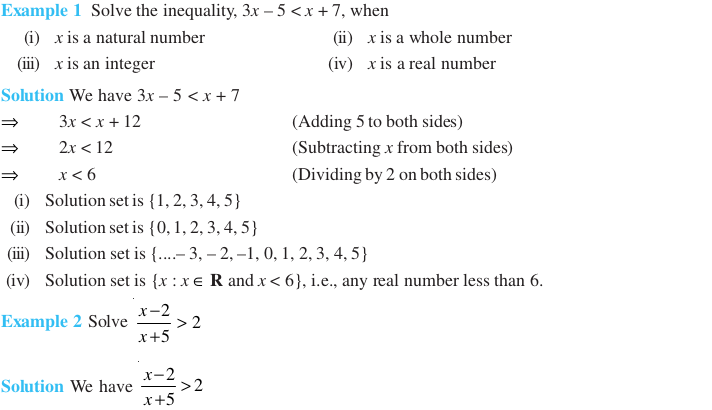
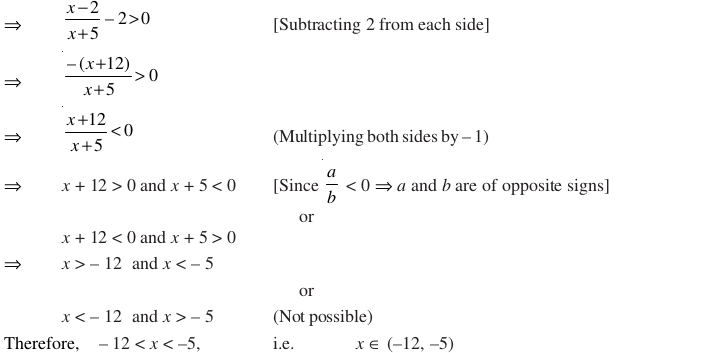



Long Type Questions (Solved Examples)



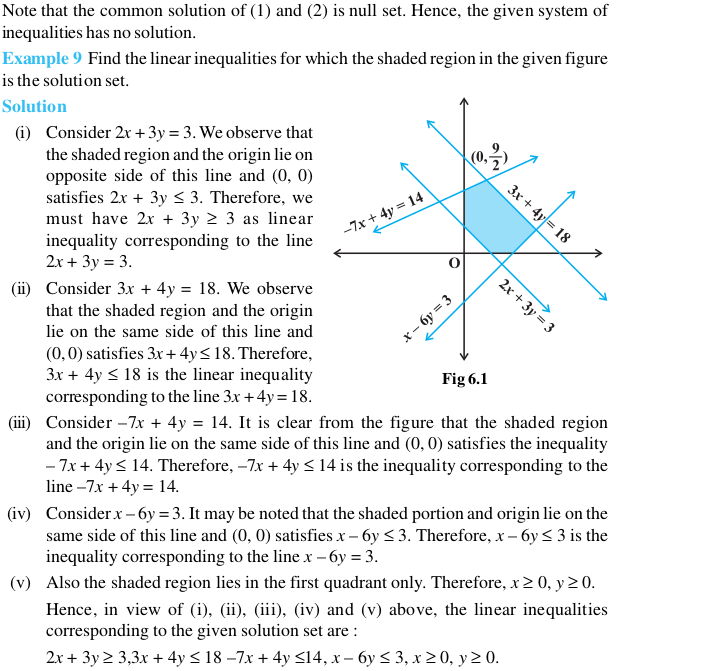
Objective Type Questions (Solved Examples)


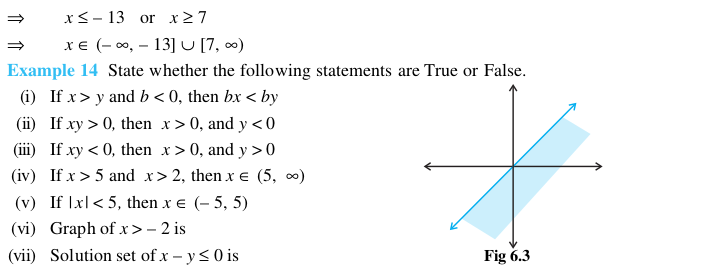

Fill in the Blanks Type Questions (Solved Examples)


Short Type Questions (Exercise)
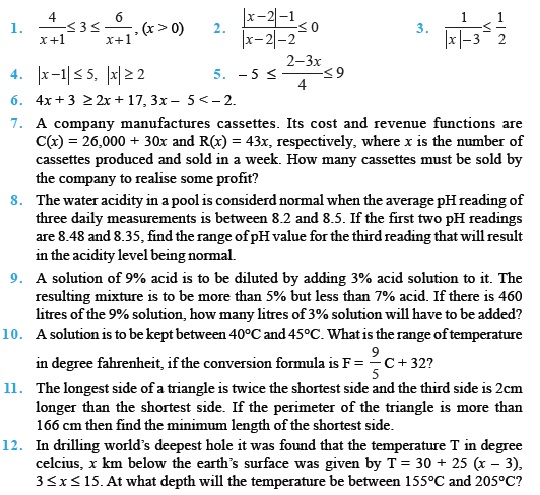
Long Type Questions
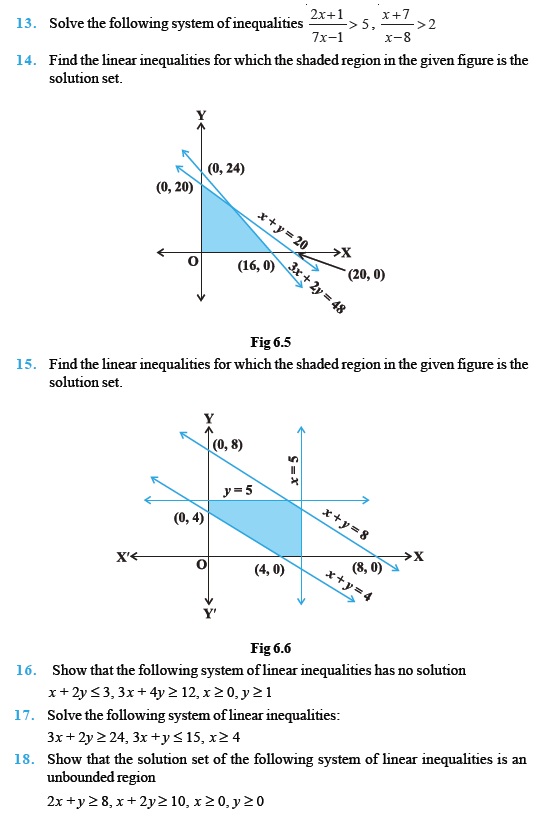
Objective Type Questions
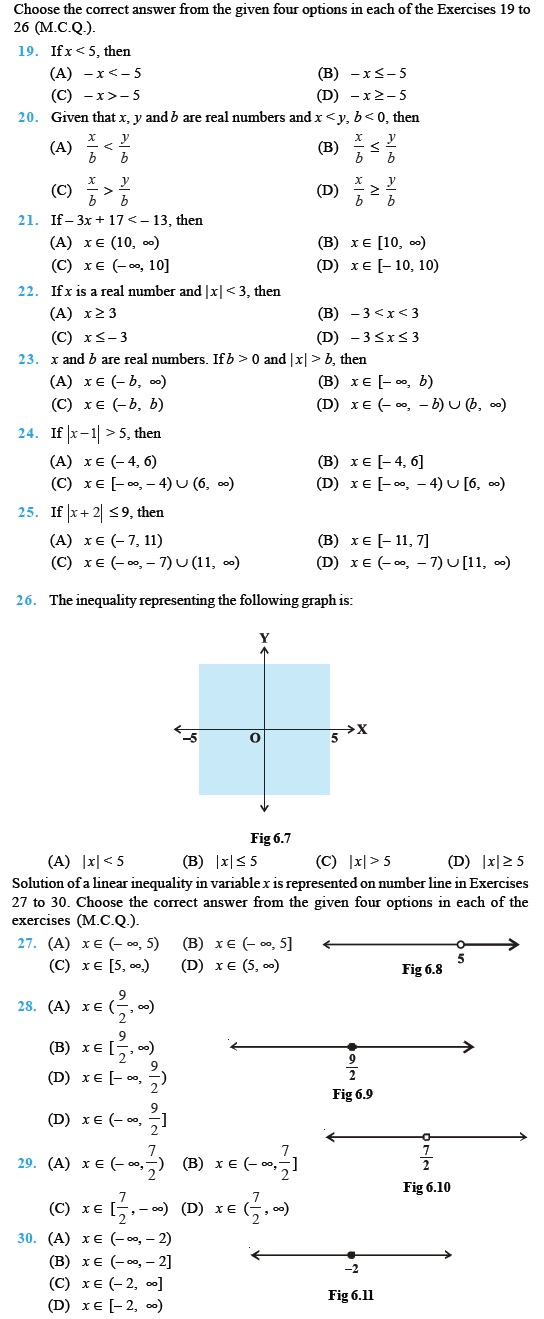
True or False Type Questions

Fill in the Blanks Type Questions
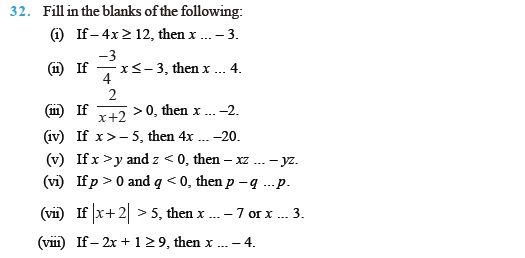
Answers


